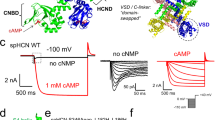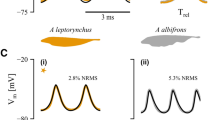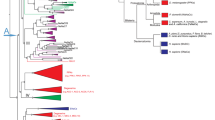Abstract
GIANT neurones of a number of molluscs are known to be able to maintain their action potentials when exposed to solutions free of sodium1–6, and in some cases to be unaffected by the poison tetrodotoxin3,6. It has been suggested that these cells may depend wholly or partly on ealcium ions to carry the inward component of their action current. In particular, this type of behaviour is observed in many of the giant neurones of the common snail, Helix aspersa. Recent evidence has suggested, however, that in the case of Helix aspersa the behaviour of the neurones could be better explained in terms of a reservoir of sodium ions, in or close to the cell membranes7. The experiments described here were designed to investigate the effect on these neurones of prolonged exposure to sodium-free Ringer, and of tetrodotoxin at concentrations up to 5 × 10−6 g/ml.
This is a preview of subscription content, access via your institution
Access options
Subscribe to this journal
Receive 51 print issues and online access
$199.00 per year
only $3.90 per issue
Buy this article
- Purchase on Springer Link
- Instant access to full article PDF
Prices may be subject to local taxes which are calculated during checkout
Similar content being viewed by others
References
Gerasimov, V. D., Kostyuk, P. G., and Maiskii, V. A., Fed. Proc., 24, T676 (1965).
Gerasimov, V. D., Kostyuk, P. G., and Maiskii, V. A., Biofizika, 10, 447 (1965).
Meves, H., Pflügers Archiv. ges. Physiol., 289, R10 (1966).
Oomura, Y., Ozaki, S., and Maeno, T., Nature, 191, 1265 (1961).
Kerkut, G. A., and Gardner, D. R., Comp. Biochem. Physiol., 20, 147 (1967).
Junge, D., Nature, 215, 546 (1967).
Chamberlain, S. G., and Kerkut, G. A., Nature, 216, 89 (1967).
Kerkut, G. A., and Thomas, R. C., Comp. Biochem. Physiol., 14, 167 (1965).
Moreton, R. B., J. Exp. Biol. (in the press).
Nakamura, Y., Nakajima, S., and Grundfest, H., J. Gen. Physiol., 48, 985 (1965).
Moore, J. W., Blaustein, M. P., Anderson, N. C., and Narahashi, T., J. Gen. Physiol., 50, 1401 (1967).
Gupta, B. L., Mellon, de F., and Treherne, J. E., Tissue and Cell, 1 (in the press).
Maddrell, S. H. P., and Treherne, J. E., J. Cell Sci., 2, 119 (1967).
Treherne, J. E., J. Exp. Biol., 42, 1 (1965).
Treherne, J. E., J. Exp. Biol., 42, 7 (1965).
Author information
Authors and Affiliations
Rights and permissions
About this article
Cite this article
MORETON, R. Ionic Mechanism of the Action Potentials of Giant Neurones of Helix aspersa. Nature 219, 70–71 (1968). https://doi.org/10.1038/219070a0
Received:
Issue Date:
DOI: https://doi.org/10.1038/219070a0
This article is cited by
-
Calcium currents in snail neurones
Pfl�gers Archiv European Journal of Physiology (1974)
-
Action of calcium on the somatic membrane of mollusk giant neurons
Neurophysiology (1974)
-
The role of low sodium ion concentrations in the generation of action potentials by neurons of the apple snail (Helix pomatia)
Neurophysiology (1969)
-
The ionic requirements for the production of action potentials in helix pomatia neurones
Pfl�gers Archiv European Journal of Physiology (1968)
Comments
By submitting a comment you agree to abide by our Terms and Community Guidelines. If you find something abusive or that does not comply with our terms or guidelines please flag it as inappropriate.



